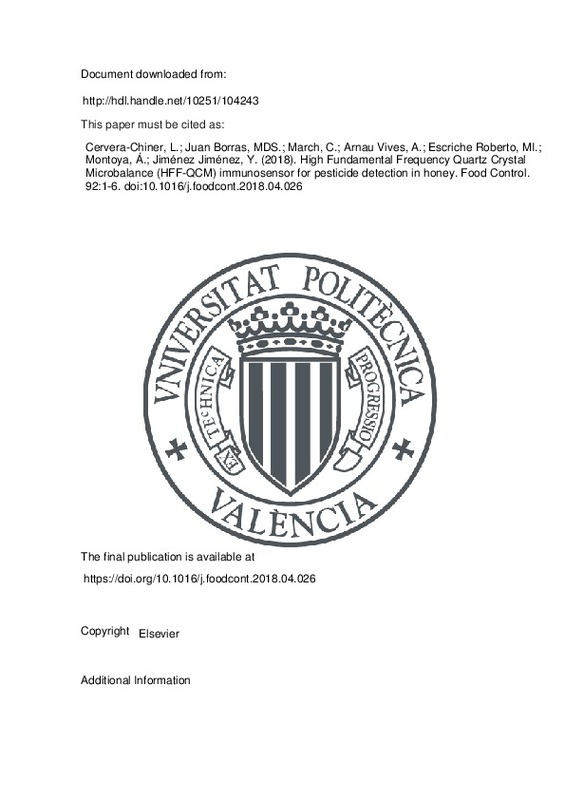JavaScript is disabled for your browser. Some features of this site may not work without it.
Buscar en RiuNet
Listar
Mi cuenta
Estadísticas
Ayuda RiuNet
Admin. UPV
High Fundamental Frequency Quartz Crystal Microbalance (HFF-QCM) immunosensor for pesticide detection in honey
Mostrar el registro sencillo del ítem
Ficheros en el ítem
| dc.contributor.author | Cervera-Chiner, Lourdes
|
es_ES |
| dc.contributor.author | Juan Borrás, María del Sol
|
es_ES |
| dc.contributor.author | March, Carmen
|
es_ES |
| dc.contributor.author | Arnau Vives, Antonio
|
es_ES |
| dc.contributor.author | Escriche Roberto, Mª Isabel
|
es_ES |
| dc.contributor.author | Montoya, Ángel
|
es_ES |
| dc.contributor.author | Jiménez Jiménez, Yolanda
|
es_ES |
| dc.date.accessioned | 2018-06-18T04:21:54Z | |
| dc.date.available | 2018-06-18T04:21:54Z | |
| dc.date.issued | 2018 | es_ES |
| dc.identifier.issn | 0956-7135 | es_ES |
| dc.identifier.uri | http://hdl.handle.net/10251/104243 | |
| dc.description.abstract | [EN] Quantification of chemical residues in honey is a market requirement to ensure consumer safety. The most common method used to analyze these compounds is the LC/MS/MS methodology, which requires highly qualified technicians and a tedious pre-treatment of the sample. The honey-packaging industry needs cheaper and faster alternatives for routine control. HFF-QCM (High Fundamental Frequency Quartz Crystal Microbalance) sensors are becoming a good option due to their high sensitivity, fast detection and low cost, while avoiding complex sample pre-treatment. The HFF-QCM technology is based on piezoelectric sensors with frequencies in the range from several tenths of MHz to hundreds of MHz. In this work a 100 MHz HFF-QCM sensor was used in a monoclonal antibody-based competitive immunoassay for specific bio-recognition of carbaryl pesticide as testing contaminant. The work intends to validate the use of HFF-QCM technology, in comparison with liquid chromatography-tandem mass spectrometry (LC-MS/MS) technique, for the detection of contaminants in honey. For this purpose, the validation criteria required by SANCO 12571/2013 guidance document were considered. The precision and accuracy (recovery) of both methods were determined by comparison of 5 replicates at 4 different concentrations (from 0 to 100 ¿g/kg) using the same honey matrix. HFF-QCM technology showed good accuracy, with recovery percentages always between 110 and 120%. As regards to precision, HFF-QCM coefficients of variation (CV) were around 10% higher than those recommended by GC SANCO 12571/2013. HFF-QCM limits of detection (LOD) and quantification (LOQ) were in the same order of magnitude as those for LC-MS/MS, which allows the analysis of carbaryl residues in honey under the established maximum residue limits (MRL), without sample pre-treatment. These results show that biosensors based on HFF-QCM technology has become a serious alternative to the traditional analytical techniques for food quality and safety applications. | es_ES |
| dc.description.sponsorship | The authors are grateful for financial support from the Ministry of Economy and Competitiveness of Spain under the project AGL2013-48646-R. We also want to thank “Generalitat Valenciana” for the financial support to hire research personnel through the grant “Ayudas para la contratación de personal investigador en formación de carácter predoctoral” to carry out this research (DOC Num.7615/15.09.2015). | |
| dc.language | Inglés | es_ES |
| dc.publisher | Elsevier | es_ES |
| dc.relation.ispartof | Food Control | es_ES |
| dc.rights | Reconocimiento - No comercial - Sin obra derivada (by-nc-nd) | es_ES |
| dc.subject | High-fundamental-frequency QCM | es_ES |
| dc.subject | Piezoelectric immunosensors | es_ES |
| dc.subject | Carbaryl | es_ES |
| dc.subject | Pesticides | es_ES |
| dc.subject | Honey | es_ES |
| dc.subject.classification | TECNOLOGIA DE ALIMENTOS | es_ES |
| dc.subject.classification | TECNOLOGIA ELECTRONICA | es_ES |
| dc.title | High Fundamental Frequency Quartz Crystal Microbalance (HFF-QCM) immunosensor for pesticide detection in honey | es_ES |
| dc.type | Artículo | es_ES |
| dc.identifier.doi | 10.1016/j.foodcont.2018.04.026 | es_ES |
| dc.relation.projectID | info:eu-repo/grantAgreement/MINECO//AGL2013-48646-R/ES/DISEÑO DE UNA PLATAFORMA BASADA EN MATRICES DE SENSORES DE CUARZO DE ALTA RESOLUCION PARA HTS (HIGH-THROUGHPUT SCREENING) DE RESIDUOS EN MIELES/ | es_ES |
| dc.rights.accessRights | Abierto | es_ES |
| dc.date.embargoEndDate | 2019-10-01 | es_ES |
| dc.contributor.affiliation | Universitat Politècnica de València. Instituto Interuniversitario de Investigación en Bioingeniería y Tecnología Orientada al Ser Humano - Institut Interuniversitari d'Investigació en Bioenginyeria i Tecnologia Orientada a l'Ésser Humà | es_ES |
| dc.contributor.affiliation | Universitat Politècnica de València. Departamento de Tecnología de Alimentos - Departament de Tecnologia d'Aliments | es_ES |
| dc.contributor.affiliation | Universitat Politècnica de València. Departamento de Ingeniería Electrónica - Departament d'Enginyeria Electrònica | es_ES |
| dc.contributor.affiliation | Universitat Politècnica de València. Instituto Universitario de Ingeniería de Alimentos para el Desarrollo - Institut Universitari d'Enginyeria d'Aliments per al Desenvolupament | es_ES |
| dc.description.bibliographicCitation | Cervera-Chiner, L.; Juan Borrás, MDS.; March, C.; Arnau Vives, A.; Escriche Roberto, MI.; Montoya, Á.; Jiménez Jiménez, Y. (2018). High Fundamental Frequency Quartz Crystal Microbalance (HFF-QCM) immunosensor for pesticide detection in honey. Food Control. 92:1-6. https://doi.org/10.1016/j.foodcont.2018.04.026 | es_ES |
| dc.description.accrualMethod | S | es_ES |
| dc.relation.publisherversion | https://doi.org/10.1016/j.foodcont.2018.04.026 | es_ES |
| dc.description.upvformatpinicio | 1 | es_ES |
| dc.description.upvformatpfin | 6 | es_ES |
| dc.type.version | info:eu-repo/semantics/publishedVersion | es_ES |
| dc.description.volume | 92 | es_ES |
| dc.relation.pasarela | S\361670 | es_ES |
| dc.contributor.funder | Ministerio de Economía, Industria y Competitividad | es_ES |







![[Cerrado]](/themes/UPV/images/candado.png)

